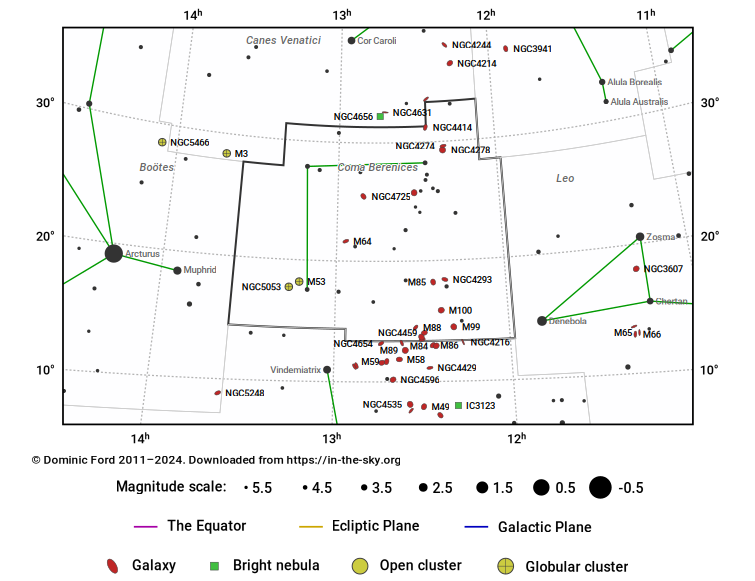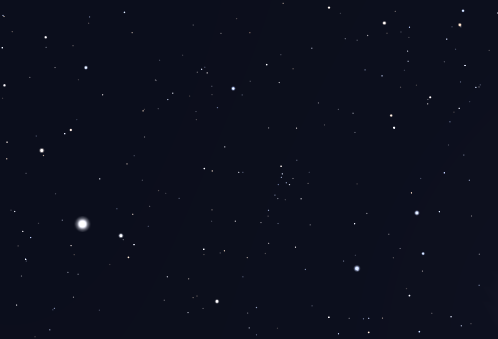The Constellation Coma Berenices
Coma Berenices is a faint constellation which lies between Bootes and Leo, visible in the northern evening sky in the months around March.
Its brightest stars are of fourth-magnitude, forming a tight swarm close to the constellation's center.
Coma Berenices was introduced by Caspar Vopel in 1536, making it the oldest surviving constellation to have been introduced since the second century. It represents the hair of Queen Berenice of Egypt, which according to legend was shaved in the third century BC in gratitude for a military victory.
Its widespread acceptance as a constellation is widely attributed to Tycho Brahe, who used it in his star catalogue in 1602. In practice the association between this sky area and a lock of hair may be much older; Ptolemy described its brightest stars as a ‘nebulous mass, called the lock’ in the second century.
The Virgo Cluster of galaxies – the biggest and brightest grouping of galaxies in the sky – extends across its southern border. Separately, it is also home to the Coma Cluster of galaxies, though this is considerably more distant and can only be seen with a large telescope.
Hover the pointer over the name of an object to highlight its position on the starchart to the right, or click to see more information.
| Stars | Open Clusters | Globular Clusters | Galaxies |
| β-Com (mag 4.2) | Messier 53 (mag 7.7) | Messier 64 (mag 8.5) | |
| γ-Com (mag 4.3) | NGC 5053 (mag 9.0) | Messier 85 (mag 9.1) | |
| α-Com (mag 4.4) | NGC 4147 (mag 10.7) | NGC 4725 (mag 9.4) | |
| 11-Com (mag 4.7) | Messier 100 (mag 9.5) | ||
| 36-Com (mag 4.8) | NGC 4565 (mag 9.6) | ||
| 23-Com (mag 4.8) | NGC 4494 (mag 9.8) | ||
| 41-Com (mag 4.8) | Messier 99 (mag 9.8) | ||
| 12-Com (mag 4.8) | NGC 4473 (mag 10.1) | ||
| 37-Com (mag 4.9) | NGC 4293 (mag 10.2) | ||
| 14-Com (mag 4.9) | NGC 4414 (mag 10.2) | ||
| 31-Com (mag 4.9) | NGC 4278 (mag 10.2) | ||
| 7-Com (mag 4.9) | NGC 4459 (mag 10.2) | ||
| 16-Com (mag 5.0) | NGC 4477 (mag 10.3) | ||
| 24-Com (mag 5.0) | Messier 88 (mag 10.3) | ||
| HIP 59856 (mag 5.0) | NGC 4274 (mag 10.4) | ||
| 35-Com (mag 5.0) | NGC 4314 (mag 10.6) | ||
| 6-Com (mag 5.1) | NGC 4710 (mag 10.7) | ||
| 27-Com (mag 5.1) | NGC 4251 (mag 10.8) | ||
| GN Com (mag 5.1) | NGC 4651 (mag 10.8) | ||
| α-Com (mag 5.2) | Messier 98 (mag 10.8) | ||
| AI Com (mag 5.2) | NGC 4350 (mag 10.9) | ||
| UU Com (mag 5.4) | NGC 4450 (mag 10.9) | ||
| 18-Com (mag 5.5) | NGC 4689 (mag 10.9) | ||
| 26-Com (mag 5.5) | Messier 91 (mag 11.0) | ||
| HIP 60170 (mag 5.5) | NGC 4394 (mag 11.0) | ||
| 5-Com (mag 5.6) | NGC 4419 (mag 11.1) | ||
| FS Com (mag 5.6) | NGC 4208 (mag 11.1) | ||
| 4-Com (mag 5.7) | NGC 4448 (mag 11.1) | ||
| 20-Com (mag 5.7) | NGC 4340 (mag 11.2) | ||
| 29-Com (mag 5.7) | NGC 4571 (mag 11.3) |




